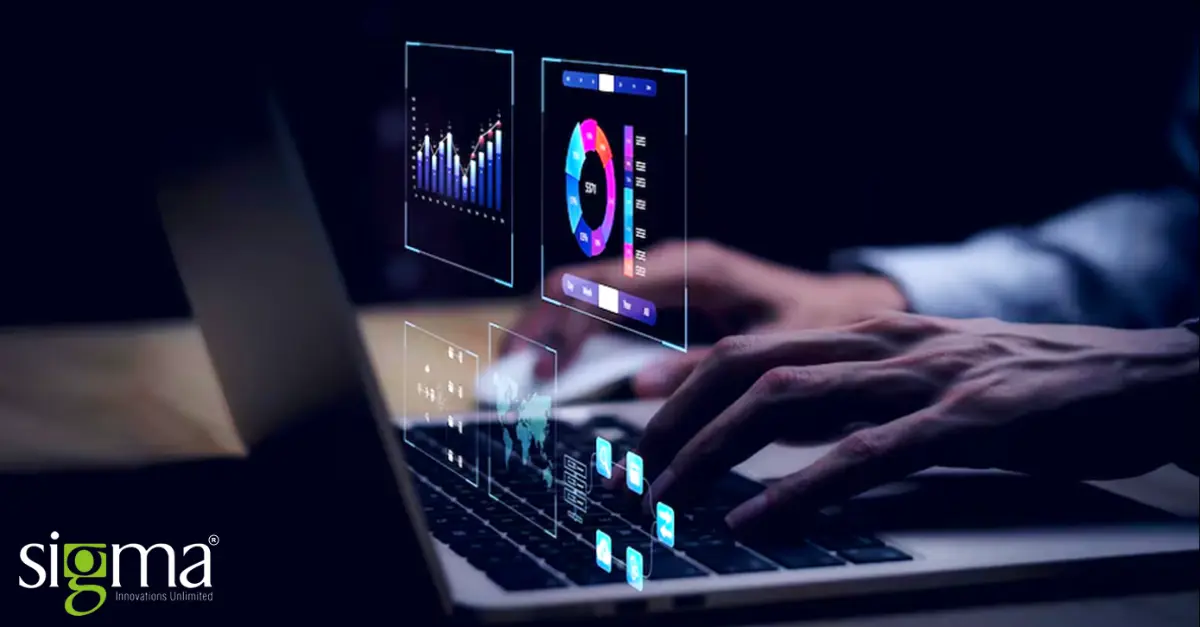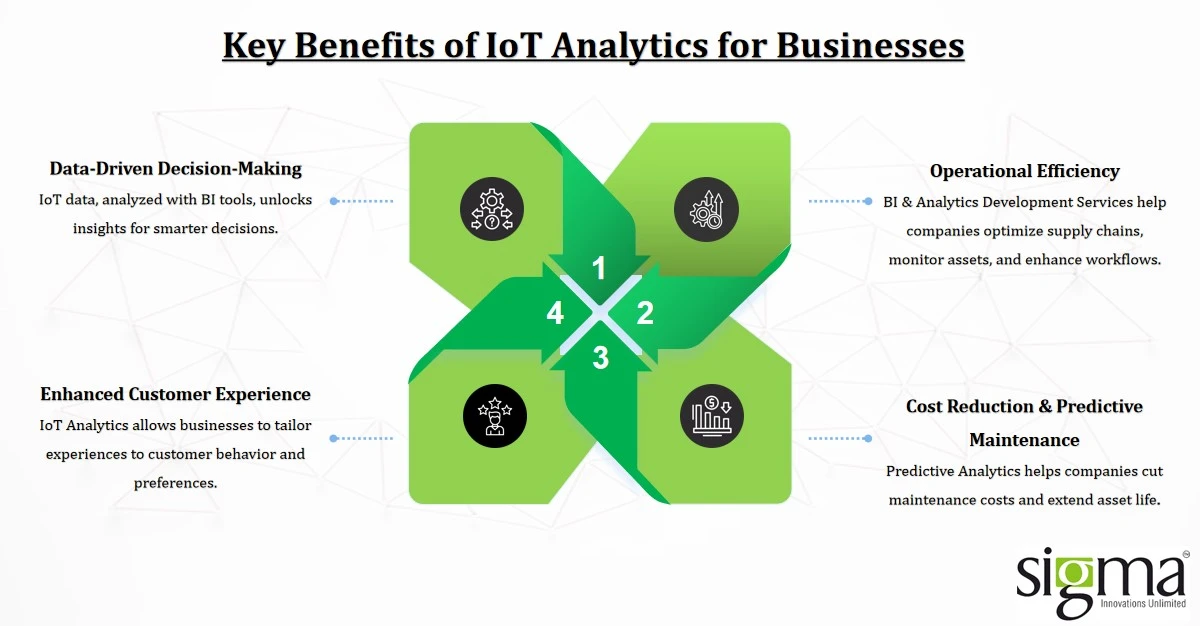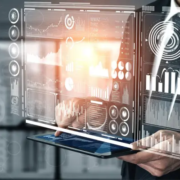Leveraging the Power of IoT Analytics in Today’s Digital World

The Internet of Things (IoT) Analytics transforms industries by turning raw data into valuable insights in the hyper-connect world. As more businesses integrate the Internet of Things (IoT) into their operations, the volume of data generated is growing exponentially. From smart homes to industrial automation, companies that leverage BI & Analytics effectively gain a competitive edge.
Projected to grow at a 24.8% CAGR from 2024 to 2030, the global IoT analytics market, valued at USD 27.41 billion in 2023, is set for rapid expansion.
– Grand View Research.
What is IoT Analytics?
IoT Analytics refers to the process of collecting, analyzing, and interpreting data from IoT-connected devices. These devices, from smart sensors to industrial machines, generate real-time data that businesses can use to optimize operations. However, analyzing this massive data pool requires advanced BI & Analytics solutions.
Key components of IoT Analytics include:
- Data Collection: IoT sensors capture real-time data from various sources.
- Data Processing: Using BI Tools, businesses clean, store, and process this data.
- Predictive Analytics: AI-driven algorithms forecast trends and prevent failures.
- Data Visualization: Business Intelligence Software transforms raw data into understandable reports and dashboards.
By implementing BI & Analytics Development Services, companies can enhance their decision-making capabilities and gain a competitive advantage.
Key Benefits of IoT Analytics for Businesses
Businesses across industries are leveraging IoT Analytics for a range of benefits, including:
- Data-Driven Decision-Making:
IoT-generated data, when processed with BI Tools, provides meaningful insights that drive smarter business decisions. - Operational Efficiency:
Companies can optimize supply chains, monitor asset performance, and improve workflow efficiency using BI & Analytics Development Services. - Enhanced Customer Experience:
IoT Analytics enables businesses to offer personalized experiences based on customer behavior and preferences. - Cost Reduction & Predictive Maintenance:
Using Predictive Analytics, companies can reduce unexpected maintenance costs and enhance asset longevity.

While IoT-generated data holds immense potential, businesses must overcome key challenges to extract meaningful insights.
The Challenges of IoT Data Analysis
Despite its benefits, analyzing IoT data presents unique challenges:
1. Massive Data Volume & Variety
IoT devices generate vast amounts of structured and unstructured data, including images, text, and video. Businesses must process and analyze this data efficiently to extract actionable insights. Traditional Business Intelligence Software often struggles to handle such diverse datasets.
2. Integrating IT and OT Data
Operational Technology (OT) data comes from manufacturing devices, sensors, and industrial machines, while Information Technology (IT) data includes CRM, ERP, and financial systems. Analyzing only one data type limits business insights. Successful IoT strategies require BI & Analytics solutions capable of integrating both IT and OT data sources.
3. Data Quality and Security Concerns
IoT data can be noisy, incomplete, or contain false readings. Cleaning and validating data before analysis is essential. Additionally, 70% of IoT devices lack fundamental security measures, making data privacy and cybersecurity critical concerns for businesses adopting IoT solutions.
How IoT Analytics Delivers Business Insights
To overcome these challenges, businesses are turning to advanced IoT Analytics platforms. These solutions enable real-time data collection, integration, visualization, and predictive modeling. Here’s how different industries benefit from IoT Analytics:
Retail & Smart Stores
- Video Analytics from IP cameras helps retailers detect theft and analyze customer behavior.
- Predictive Analytics using temperature and humidity sensors help prevent spoilage and optimize inventory.
- Real-time Pricing solutions adjust discounts based on consumer demand and digital shelf activity.
Home Automation & Security
- IoT-powered smart homes integrate multiple sensors to enhance security and energy efficiency.
- AI-driven Business Intelligence Software analyzes user behavior for automated adjustments to lighting, temperature, and security systems.
Manufacturing & Predictive Maintenance
- IoT Analytics detects anomalies in machine performance and predicts failures before they happen, reducing downtime.
- Industrial sensors track energy consumption, optimizing resource allocation for cost savings.
Agriculture & Precision Farming
- IoT sensors monitor soil conditions, weather patterns, and crop health, allowing farmers to make data-driven decisions.
- BI Tools generate reports that optimize irrigation and fertilizer use, increasing yield and reducing waste.
Logistics & Fleet Management
- IoT devices track real-time vehicle locations, optimizing delivery routes and reducing fuel costs.
- Business Intelligence Software identifies bottlenecks and suggests improvements for efficient supply chain management.
The Future of IoT Analytics
The next wave of BI & Analytics Development Services will incorporate AI-driven Predictive Analytics, making IoT-powered insights even more accessible. Edge Computing will also play a crucial role, allowing real-time processing of data at the device level, reducing latency, and improving efficiency. Here are some emerging trends:
1. AI-powered IoT Analytics
Imagine smart machines that know when they’re about to break down. AI helps IoT by automatically finding hidden patterns in tons of data. This means machines can predict problems before they happen, saving time and money. AI also helps personalize things, like suggesting products you might like.
2. Edge Computing for Real-Time Processing
Think of a robot on a factory floor that needs to react instantly. Edge computing processes data right on the spot, near the robot itself, instead of sending it far away to a server. This makes decisions super fast, which is crucial for things like robots, self-driving cars, and even your smart speaker to understand your commands instantly.
3. Enhanced Security
With everything connected, security is important. IoT analytics can spot suspicious activity, like someone trying to hack into your smart home. By noticing unusual patterns, it can help prevent cyberattacks and keep your data safe.
4. Digital Twins
Imagine a virtual copy of a jet engine. Sensors on the real engine send data to this “digital twin.” Engineers can then test different things on the digital twin to see how the real engine will perform, saving time and money on real-world tests.
5. Data Visualization and Dashboards
All that data is useless if it’s confusing. IoT analytics creates simple charts and graphs that make the information easy to understand. Imagine a doctor seeing a patient’s heartbeat on a clear dashboard, or a city manager seeing a map of traffic with color-coded alerts.
6. Integration with other technologies
IoT is teaming up with other technologies. Imagine using your phone to see a 3D model of a product in your living room before you buy it (Augmented Reality). Or imagine super-fast internet (5G) making IoT even faster and more reliable. These combinations open up even more possibilities.
Take the Next Step with BI & Analytics Development Services
IoT Analytics is not just a trend—it’s a business necessity. By leveraging BI & Analytics, organizations can optimize operations, enhance customer experiences, and drive revenue growth. However, successful IoT implementation requires expertise, robust security, and the right analytical tools.
At Sigma Infosolutions, we offer cutting-edge BI & Analytics Development Services to help businesses harness the power of IoT. Our solutions integrate seamlessly with leading BI Tools and Business Intelligence Software to transform raw IoT data into actionable insights.
Ready to unlock the power of IoT Analytics? Contact us today to explore how our BI & Analytics Development Services can revolutionize your business!
